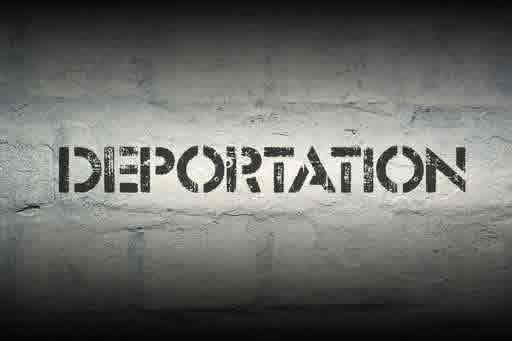
The immigration judge was not in a good mood.
Before my client’s removal hearing began, the judge scolded the government attorney.
As a deportation defense lawyer, it was clear the Immigration and Customs Enforcement war on immigrants was causing administrative problems for the immigration court.
“I am putting you on notice,” noted the judge, “that I am closing my courtroom down at 11:30 sharp.”
He elaborated.
“Do not think you can continue to add 40 new cases to my calendar whenever you feel like it? I am not going to keep sacrificing my lunch to accommodate your agency. Tell your supervisors that if we cannot finish the calendar by noon, you will have to return at 1:00 p.m.”
Political Deceit And Statistics: Conflicting Headlines Or Conflicting Policies?
In recent weeks, there has been a flurry of news about deportation statistics.
Clarity about the direction of immigration law has been conspicuously absent.
Whether due to careless inadvertence, cruel indifference, or calloused intentions, the inconsistency from press release to press release is baffling even for seasoned reporters.
As a result, many of their headlines contradict each other.
For instance:
- On October 18, 2011, USA Today announced “Most illegal immigrants deported last year were criminals”.
- Merely two days later, on October 20, 2011, CNN declared “Deportation reviews to begin shortly”.
- Then, on October 25, 2011, the Riverside Press Enterprise proclaimed, “Deportation rates drop in California”.
When major media outlets highlight such contrary trends, who can blame the public for its confusion about immigration issues?
The real question is not whether the headlines contradict each other. Rather, the inquiry should be whether underlying immigration policies are in conflict.
October 18, 2011 News: Record-Breaking Deportations
Immigration and Customs Enforcement (ICE) Director John Morton revealed 396,906 immigrants were deported in fiscal year 2011. This is a new one-year record.
According to Morton, approximately 55% were “criminal aliens.” The other 45% had no criminal records.
However, Morton’s commentary is not entirely accurate.
A close look at the numbers show perhaps up to 83% of the deportees did not fit into the serious criminal offense category.
October 20, 2011 News: Too Many Deportation Cases
Janet Napolitano, Department of Homeland Security Secretary, announces the Obama administration will begin reviewing deportation cases at immigration courts in 2 -3 weeks.
The review panel’s first task is to distinguish low priority from high priority cases. High priority cases involve immigrants who have committed serious criminal offenses. Those who have been convicted of minor crimes, or no crimes, and can show strong family and community ties, fall into the low priority cases.
The primary goal, says Napolitano, is to keep low priority cases from entering and cluttering the immigration court system. Additionally, the panel hopes to remove low priority matters from the overburdened judicial dockets.
I was surprised Napolitano was not questioned about the administration’s policy conflict between record-breaking detention numbers and reducing the immigration court overload.
October 25, 2011 News: Less Immigrants Being Deported
California Watch, a nonprofit, nonpartisan investigative news group, reports the number of immigrants deported by immigration judges have declined about 10% in recent years.
This figure seems to clash with both sets of statistics given a week earlier.
On the one hand, if the number of detainees are increasing at a record pace, how can the courts be deporting less individuals?
On the other, if judges are deporting less immigrants, is there really a need to take lower priority cases out of the system?
A Broken Immigration Court Agenda
In actuality, assuming immigration courts are deporting fewer immigrants, there are three possible reasons:
- First, fewer cases are entering the immigration court system. This is unlikely, given ICE’s record breaking year.
- Second, more immigrants are winning their deportation cases. As a San Diego immigration lawyer, I know this is not taking place.
- Third, less matters are being processed to completion. This is the most likely reason for the lower amount of deportations.
Putting it all together, a picture of a broken immigration court agenda emerges.
As more cases enter the system, the backlog grows. As the backlog grows, hearing dates are stretched out. This means it longer to complete immigration cases.
Fewer completions equals fewer deportations.
This process begs the real issue.
Is this administration committed to focusing on serious criminals and violent offenders?
Or is this administration committed to reaching its deportation quotas, regardless whether serious or non-serious offenders are removed from the U.S.?
Immigration Politics As Usual

The reasons for the public’s confusion goes deeper than policy conflicts.
The incompatibility of the administration’s immigration policies is related to the 2012 election.
The conflicts among the various policies reflect reflect the president’s deliberate effort to avoid transparency on immigration issues.
In an effort to appear a centrist, the president introduced the concept of deportation quotas a few years ago.
To meet these quotas, immigration law enforcement agencies have aggressively pursued higher deportation numbers than under his predecessors.
At the same time, to appease immigration reform supporters, the president has floated the idea of immigration court review panels. These panels, yet to be officially implemented, are intended to defuse the criticism that too many immigrant families are being destroyed via the deportation process.
The president should know better. It’s impossible to have it both ways.
Listening to the president on immigration, Mark Twain would likely note, “There are three kinds of lies: lies, damned lies, and deportation statistics.”
Quota? What Quota?
It seems like light-years ago that a leaked memo surfaced revealing the Department of Homeland Security had set a quota for annual deportations at 400,000. Yet, it was merely 18 months ago.
The news spread like wildfire, sparking criticism from pro-immigration advocates. Quickly, the Obama administration sought to offset the memo’s validity.
Just a few months later, amidst growing dissent, DHS Secretary Janet Napolitano acknowledged the 400,000 quota.
Caught with its hands in the cookie jar, the government admitted the obvious, hoping to mute criticism.
It worked.
Two weeks ago, when the administration announced record deportation numbers for the third consecutive year, public opposition was much quieter than in the previous two years.
In part, the outcry against the level of deportations may have been short-lived due to other issues facing the public.
Yet, in my view, factors like burnout, apathy, and politics also played a role. I sense the public has grown tired of immigration news, especially when little, if anything, is being done to fix the immigration system.
Since immigration is a peripheral issue for many citizens, they have started to turn off to the subject.
The upcoming election has accelerated this process. Conservatives and liberals are settling into their respective camps and the party platforms are starting to emerge. For true believers, immigration reform is not on the party agenda.
For example, Obama supporters continuously minimize the social impact of his record-breaking deportations by suggesting the situation will be worse if a GOP candidate wins the next election.
No surprise, then, most of the public has become immune to a 400,000 deportation quota.
Behind The ICE Numbers For 2011
According to ICE Director John Morton, the government deported 396,906 immigrants from October 2010 to September 2011.
This marks the third year in a row where the Obama administration has set new deportation standards.
There were 392,862 deportations made from October 2009 through September 2010.
In the first year under President Obama, the Department of Homeland Security reported 298,401 immigrants were removed from the United States. An additional 89,389 immigrants left under voluntary departure orders. Combined, the 2009 total was 387,790 deportations.
In fiscal year 2008, during George Bush’s final year as President, the government removed 264,541 immigrants and 104,680 left the country.
At the press conference, Morton noted the deportation news was the outcome of a “focus on sensible immigration.”
He added, “In the face of limited resources, we have to prioritize, and that starts with criminal offenders.”
Morton’s statement is a watered-down version of Obama’s claims over the past few years. The shift went largely unmentioned, if not undetected.
According to the president, federal law enforcement efforts would target immigrants with serious criminal convictions. In fact, administration officials have often noted their focus is on removing criminal illegal immigrants “who pose a national security or public safety threat.”
There’s a reason for the unnoticed shift in the administration’s rhetoric.
Statistics reveal the answer.
DHS claims 55% of the nearly 397,000 deportees were “criminal aliens.” The question remains, however, how many of them committed serious criminal offenses.
DHS Deportation figures for the major categories of serious crimes shows:
- Homicide (1,119)
- Sexual Offenses (5,848)
- Drug-Related Offenses (44.653)
- Driving Under The Influence (35.927)
- Traffic Offenses (13,028)
That’s a total of 100,575.
55% of 397,000 equals 218,350. So what are the crimes committed by the other 118,350 serious criminal offenders?
Moreover, as some commentators have already noted, many of the drug-related, DUI, and traffic convictions are not serious crimes. Many warranted only a minimum punishment at state court, but are classified as a serious offense under arcane immigration rules.
If merely 1/3 of the drug, DUI, and traffic convictions fall into this category, that’s another 31,000 excluded from the “national security or public safety threat” classification.
Then there’s the issue of the unaccounted 45%, or 179,000 deportees.
Added together, a modest estimate would suggest approximately 328,000 of the 397,000 deportees, nearly 83%, fail to meet the serious criminal offender criteria touted by the president just one year earlier.
The Obama Immigration Election Plan
The Obama election game plan is based on a two-part blueprint.
One, pin the lack of progress on immigration reform issues on the Republicans. This allows the president to campaign as the better choice, if no longer the champion, for immigrant communities.
Two, placate middle-of-the-road voters by not actively supporting immigration reform issues and supporting stronger anti-immigrant deportation measures.
Obama supporters assert my analysis of the president’s game plan is unduly harsh. They claim that I fail to understand political reality.
I disagree.
When I go to immigration court and fight for the release of an immigrant who has no criminal convictions, two U.S. children, a U.S. citizen wife, and lived here since the age of seven, that’s not just a legal reality.
It’s also a political reality.
When I go to court for an immigrant with no convictions, that’s not just legal reality. It’s also political reality.
It’s politics that make this individual subject to detention, except on payment of an excessive bond, while at the same time stripping him of most avenues to legalize his status.
It’s politics that led ICE to pick him up at work while he was peacefully try to earn a living to feed his wife and children.
It’s politics that causes an immigration judge to rip into ICE for excessively loading up his calendar with immigrants as if they’re merely herds of human cattle.
And it’s politics when the president enters the White House on a promise to push true immigration reform and yet allows immigrants to be deported in record numbers on a false pretense they are serious criminal offenders.
In other words, the deportation of immigrants has been reduced to reelection fodder for both political parties.
That’s political reality.
By Carlos Batara, Immigration Law, Policy, And Politics




